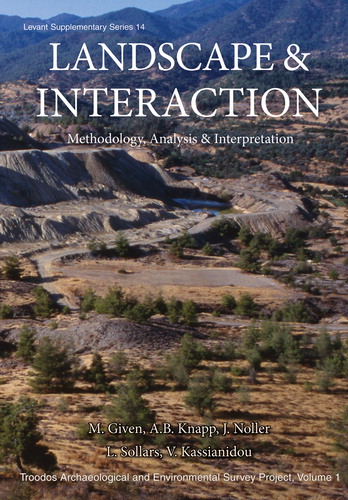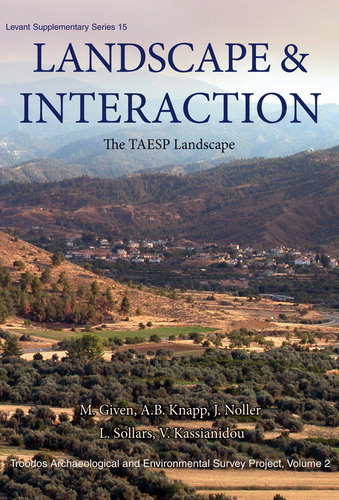CBRL members receive a 20% discount
Latest
Given, Michael, Knapp, A. Bernard, Noller, Jay, Sollars, Luke and Kassianidou, Vasiliki (2013) Landscape and Interaction, Troodos Survey. Vol 1: Methodology, Analysis and Interpretation. Levant Supplementary Series 14, Oxford: OxbowBooks, £48
The Troodos Mountains, in central Cyprus, is a region of great physical and cultural diversity. The landscapes range from fertile, cultivated plains to narrow, dry valleys and forested mountain regions and this physical topography is overlain with a rich human cultural landscape of farming, mining, industry, settlement, burial and ritual behaviour. Over six ?eld seasons, a team of specialists and ?eldwalkers from the Troodos Archaeological and Environmental Survey Project (TAESP) investigated the northern edge of this region and explored the complex and dynamic relationship between landscape and people over 12,000 years. The results of their integrated and interpretative approach are presented here, in the ?rst of two volumes. Beginning with a considered overview of the context, research aims and methodology of the project, Volume 1 provides detailed accounts of the archaeology, material culture, geography and environmental record of the entire survey area. This wealth of information is then bought together to produce a series of chronological and thematic analyses of the interaction between people and landscape in this region of Cyprus from the Prehistoric through to the Modern period.
Given, Michael, Knapp, A. Bernard, Noller, Jay, Sollars, Luke and Kassianidou Vasiliki (2013) Landscape and Interaction, Troodos Survey. Vol 2: The TAESP Landscape. Levant Supplementary Series 15, Oxford: Oxbow Books, £38
The TAESP Landscape, the second of two volumes, presents an area-by-area analysis of the ?eldwork and research undertaken by the Troodos Archaeological and Environmental Survey Project (TAESP) in the Troodos Mountains of Cyprus. Covering four regions of the survey area (The Plains, Karkotis Valley, Upper Lagoudhera Valley and The Mountains) the volume focuses on explicit research questions appropriate each region. Organized geographically, chronologically and thematically, each region is investigated from the Neolithic to the present day and, through ‘Intensive Survey Zones’—selected to give a representative range of the physical and cultural terrain— many notable new discoveries are made. These include the pattern of Bronze Age Settlement in the Plains, Archaic rural sanctuaries and cemeteries, the scope of Late Roman copper-mining and isolated Medieval mountain settlements. The TAESP Landscape provides a fully integrated and data-rich analysis of the material from a wide range of contrasting archaeological perspectives. Taken together, these wide-ranging and interdisciplinary perspectives give a nuanced and sensitive approach to a strikingly multi-faceted landscape.
Garrard, A. N. and Byrd, B. F. (2013) Beyond the Fertile Crescent: Late Palaeolithic and Neolithic Communities of the Jordanian Steppe. The Azraq Basin Project, Volume 1: Project Background and the Late Palaeolithic (Geological Context and Technology). Levant Supplementary Series 13, Oxford: Oxbow Books, £45
The natural arc of resource-rich land which forms the ‘Fertile Crescent’ of Southwest Asia is widely regarded as the earliest centre of village-based farming in the world. It has been the focus of much research on the transition from Epipalaeolithic hunting and gathering to Neolithic farming. Beyond the Fertile Crescent is the ?rst volume of the Azraq Basin Project, a large-scale archaeological and palaeoenvironmental survey and excavation project undertaken between 1982 and 1989 at the margins of this region, in the steppe and oasis environments of the Azraq Basin in north-central Jordan. This is a region rich in Palaeolithic and Neolithic sites. Beginning with an overview of the Project’s aims, a detailed analysis of past and present environments, and the history of survey and excavation in the Basin, Beyond the Fertile Crescent explores the geology, stratigraphy and dating of the Late Palaeolithic sites and provides a detailed description of the technology and typology of the chipped stone assemblages from the sites. These are then compared with those from the wider Levant, in order to explore possible links between technological traditions and social groups and to reconstruct settlement strategies across the region.
Betts, A. V. G., Cropper, D., Martin, L. and McCartney, C. (2013) Later Prehistory of the Badia. Levant Supplementary Series 11, Oxford: Oxbow Books, £48
The Jordanian badia is an arid region that has been largely protected from modern development by its extreme climate and has preserved a remarkably rich record of its prehistoric past. This is the second of two volumes to document extensive surveys and excavations in the region from Al-Azraq to the Iraqi border over the period 1979–1996.
Broadly, it covers the Late Neolithic and Chalcolithic of the eastern badia, which witnessed a further spread of campsites and short-term occupation out around the edges of the harra and across the hamad as far as the lands bordering the Euphrates to the north and east. This period was marked by the ?rst appearance of sheep and goat as one element of the steppic economy alongside traditional practices of hunting and foraging.
Forthcoming:
Parr, Peter J. (editor), with contributions by Bettles, E. A., Copeland, L., Grigson, C., Mathias, V. T., Moffett, L., Molleson, T., Moussli, M., Nishiaki, Y., Parr, P. J. and Smith, W. Excavations at Tell Nebi Mend, Syria, Vol 1
This volume is the first of several which will present the results of excavations carried out between 1975 and 1996 by the Institute of Archaeology, University College London, at Tell Nebi Mend in western Syria. The site lies in one of the most fertile and strategic regions of the Levant, and can be identified both with Qadesh-on-the-Orontes, where the Egyptian and Hittite armies clashed round about 1300 BC, and with Laodiceia-ad-Libanum, an important provincial town in the Seleucid and Roman empires. The excavations have shown that the initial settlement of the site happened long before this however, and this first volume is mostly devoted to the remains of the Pottery Neolithic period of the 7th millennium BC, including a large and diverse collection of decorated pottery, as well as important archaeozoological and archaeobotanical data. The volume also contains a discussion of work on the enigmatic fortified enclosure south of the main mound, and begins with a general introduction to the site, previous research, and the recent excavations. Future volumes, in active preparation, will deal with the later occupation, down to the 5th century AD, when the sites appears to have been abandoned before being resettled in Ottoman times.
Peltenburg, E. Tell Jerablus Tahtani, Syria, Vol 1. Mortuary Practices at an Early Bronze Age Fort on the Euphrates River
Jerablus Tahtani, a multi-period tell site on the great bend of the Euphrates River in northern Syria, was excavated by a team from the University of Edinburgh from 1992 to 2004 within the framework of the international Tishrin Dam Salvage programme. Results have shed important light on prehistoric developments at its imposing neighbour, Carchemish, on the Uruk expansion in the 4th millennium BC, extraordinary Euphrates flood episodes in the 3rd millennium BC and the ‘second urban revolution’ in Early Bronze Age Syria. This volume, the first major report on the site, deals with stratified mortuary evidence found at the Bronze Age fort at a time when Ebla claimed supremacy of this part of the Euphrates River valley. In addition to more than 50 graves, considered in terms of site abandonment processes, the excavations at Jerablus revealed a monumental tomb incongruously located at this small fort. Its creation and life history are evaluated in the context of other highly conspicuous mortuary facilities in the region—monuments that served as places of social memory and vehicles for structuring a distinctive regional political trajectory within the Bronze Age of the Ancient Near East.
Other CBRL Monographs in Archaeology
The Medieval and Ottoman Hajj Route in Jordan: An Archaeological and Historical Study, edited by Andrew Petersen (2012), Levant Supplementary Series 12, £52
Umm al-Biyara: Excavations by Crystal-M. Bennett in Petra 1960–1965, by Piotr Bienkowski (2011), Levant Supplementary Series 10, £35
Culture, Chronology and the Chalcolithic, edited by J. Lovell and Y. Rowan (2011), Levant Supplementary Series 9, £40
Landscapes in Transition, edited by Bill Finlayson and Graeme Warren (2010), Levant Supplementary Series 8, £35
Excavations by K.M. Kenyon in Jerusalem 1961–1967. Volume 5: Hellenistic to Ottoman Jerusalem, edited by K. Prag. Excavations in Jerusalem 1961–1967, Vol. 5 (2008), Supplementary Series 7, £15
Archaeology and Desertification: The Wadi Faynan Landscape Survey, Southern Jordan, by G. Barker, D. Gilbertson and D. J. Mattingly (2008), Supplementary Series 6, £10
Euphrates River Valley Settlement: the Carchemish Sector in the 3rd Millennium BC, edited by E. Peltenburg (2007) Supplementary Series 5, £10
The Early Prehistory of Wadi Faynan, Southern Jordan: Excavations at the Pre-Pottery Neolithic A site of WF16 and Archaeological Survey of Wadis Faynan, Ghuwayr and Al Bustan, edited by B. Finlayson and S. Mithen. Wadi Faynan Series 1 (2007), Supplementary Series 4, £10
Crossing the Rift: Resources, Routes, Settlement Patterns and Interaction in the Wadi Arabah, edited by P. Bienkowski and K. Galor (2006), Supplementary Series 3, £10
Archaeological Perspectives on the Transmission and Transformation of Culture: A View from the Eastern Mediterranean, edited by J. Clarke (2005), Supplementary Series 2, £40
British Academy Monographs in Archaeology
Excavations in Jerusalem 1961–1967, Volume II: The Iron Age Extramural Quarter on the South-East Hill, by H. J. Franken and M. L. Steiner (1990), £12.95
Excavations by K.M. Kenyon in Jerusalem 1961–1967, Volume IV: The Iron Age Cave Deposits on the South-East Hill and Isolated Burials and Cemeteries Elsewhere, edited by I. Eshel and K. Prag (1995), £14.95
Excavations at Tawilan in Southern Jordan, by C.-M. Bennett and P. Bienkowski, with contributions by Khairieh ‘Amr et al. (1995), £10
Upper Zohar, an Early Byzantine Fort in Palaestina Tertia: Final Report of Excavations in 1985–1986, by R. P. Harper. with contributions by G. Clark et al. (1995), £5
Qal’at Ja’bar Pottery: A Study of a Syrian Fortified Site of the Late 11th–14th Centuries, by C. Tonghini, with contributions by H. J. Franken et al. (1998), £10
Busayra: Excavations by Crystal-M Bennett 1971–1980, by P. Bienkowski, with contributions by M. Balla et al. (2002), £20
Jericho
Excavations at Jericho, Volume 1: The Tombs Excavated in 1952–4, by K. Kenyon, with contributions by E. Crowfoot et al. (1960), £50
Excavations at Jericho, Volume 2: The Tombs Excavated in 1955–8, by K. Kenyon, with contributions by C.-M. Bennett et al. (1965), £50
Excavations at Jericho, Volume 3: The Architecture and Stratigraphy of the Tell, by K. Kenyon, edited by T. A. Holland, with contributions by R. Burleigh et al. (1981), £29.95
Excavations at Jericho, Volume 4: The pottery type series and other finds, by K. Kenyon and T. A. Holland, with contributions by J. R. Bartlett et al. (1982), £5
Jericho V: The Pottery Phases of the Tell and Other Finds, by K. Kenyon and T. A. Holland, with contributions by R. Burleigh et al. (1983), £5
The Red Tower (al-Burj al Ahmar), AD 1099–1516. Settlement in the Plain of Sharon at the Time of the Crusaders and Mamluks, by D. Pringle, with contributions by J. Cartledge et al. (1986), £5
The Roman Army in Jordan (second edition), by D. Kennedy (2004), £10
Available for purchase from: www.oxbowbooks.com
Oxbow Books, 10 Hythe Bridge Street, Oxford, OX1 2EW, United Kingdom
Tel: +44 (0)1865 241249
Orders: [email protected]


